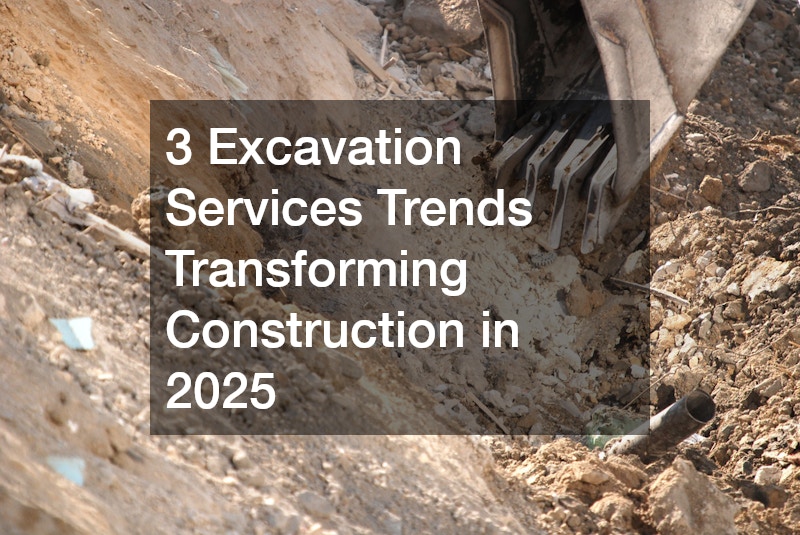Excavation services are evolving quickly to meet the growing demands of modern construction in Australia. As technology, sustainability and safety expectations shift, the way sites are prepared and managed is transforming at a steady pace.
In 2025, builders and developers are looking beyond traditional excavation methods to adopt smarter and more efficient techniques.
The right excavation services are no longer just about digging and removing earth. They play a central role in ensuring a project starts on solid ground—literally and figuratively. These services impact everything from timelines and budgets to site safety and compliance. With projects becoming more complex, the push for innovation in excavation is changing how contractors and property owners approach the earliest stages of development.
Here are three major trends in excavation services shaping construction this year.
1. Smart Technology Integration
One of the most significant trends reshaping excavation in 2025 is the integration of smart technology. GPS-guided machinery, 3D modelling software and real-time data tracking have changed how sites are assessed and excavated. Excavators are now using equipment that can follow precise digital plans, reducing the margin for human error and increasing accuracy.
This approach has proven to save time and reduce costs. Crews no longer rely on manual measurements or paper blueprints to guide excavation. Instead, they use advanced systems that provide instant feedback, helping operators adjust depth, slope and alignment on the fly. It also means fewer corrections and less rework later in the construction process.
Drones are also being used for surveying and monitoring, giving site managers a bird’s-eye view of progress and allowing for faster reporting. As a result, excavation services are not only more precise but also safer and more transparent. This level of detail is particularly helpful for large commercial sites or developments that must meet strict regulatory requirements.
2. Sustainable and Eco-Friendly Practices
Sustainability has become a priority for many industries, and excavation is no exception. In 2025, environmental responsibility is playing a bigger role in how excavation services are planned and carried out. With greater pressure from regulators and communities, companies are taking steps to reduce their environmental impact.
Modern excavation methods aim to disturb less land and preserve more natural features. This includes careful planning to reduce soil erosion, reuse excavated materials and protect water systems. Some companies are even using electric-powered excavation machinery to cut down on emissions, especially on projects in residential or sensitive areas.
Site remediation and soil testing are also becoming standard procedures, ensuring that land remains safe and usable after construction. Whether it’s a small urban infill site or a large-scale development, excavation teams are expected to follow best practices that limit their carbon footprint and align with broader sustainability goals.
Excavation services that embrace environmentally conscious methods not only benefit the planet but also appeal to property developers who want to market their projects as green and future-ready.
3. Increased Focus on Safety and Compliance
Workplace safety remains a key focus in the construction sector, and excavation is one area where the risks can be particularly high. In 2025, excavation services are seeing a stronger push toward compliance with national safety standards and improved worksite protocols.
Advancements in safety training, automated monitoring and machinery controls have helped reduce the likelihood of accidents. Many excavation teams now use wearable technology and site sensors to detect movement, changes in ground stability or the presence of underground utilities before work begins.
New regulations have also influenced how excavation permits are obtained and how safety plans are submitted. More councils and government bodies require digital documentation, including geotechnical assessments and site hazard reports, before excavation can commence. This added oversight ensures a higher level of accountability and helps projects avoid costly delays or legal issues.
Clients and developers are increasingly selecting excavation services providers who have a strong track record in safety and compliance. These expectations reflect a broader industry trend toward professionalism and risk management.
Looking Ahead
The demand for smarter, greener and safer construction has positioned excavation as a high-impact part of every project. In 2025, excavation services are no longer just an early step in development—they’re a strategic advantage when managed correctly.
Contractors who invest in new technology, train their teams on sustainable methods and maintain strict safety standards are leading the field. Likewise, developers and property owners who partner with forward-thinking excavation providers are more likely to stay on budget, on schedule and in line with regulations.
As the construction industry continues to evolve, the role of excavation will remain essential. The trends seen today are setting a new standard for how sites are prepared and developed in the years to come.
Whether you’re planning a new build, upgrading existing infrastructure or taking on a large-scale commercial project, choosing excavation services that align with current best practices can ensure your project starts strong and stays compliant every step of the way.

